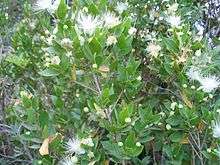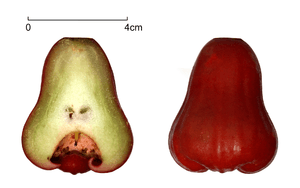Myrtaceae
Myrtaceae or the myrtle family is a family of dicotyledonous plants placed within the order Myrtales. Myrtle, pohutukawa, bay rum tree, clove, guava, acca (feijoa), allspice, and eucalyptus are some notable members of this group. All species are woody, contain essential oils, and have flower parts in multiples of four or five. The leaves are evergreen, alternate to mostly opposite, simple, and usually entire (i.e., without a toothed margin). The flowers have a base number of five petals, though in several genera the petals are minute or absent. The stamens are usually very conspicuous, brightly coloured and numerous.
| Myrtle family | |
|---|---|
 | |
| Myrtus communis foliage and flowers | |
| Scientific classification | |
| Kingdom: | Plantae |
| Clade: | Tracheophytes |
| Clade: | Angiosperms |
| Clade: | Eudicots |
| Clade: | Rosids |
| Order: | Myrtales |
| Family: | Myrtaceae Juss.[1] |
| Genera | |
|
About 130; see list | |
_W_IMG_2431.jpg)
Evolutionary history
Scientists hypothesize that the family Myrtaceae arose between sixty and fifty-six million years ago during the Paleocene era. Pollen fossils have been sourced to the ancient supercontinent Gondwana.[2] The breakup of Gondwana during the Cretaceous period (145 to 66 Mya) geographically isolated disjunct taxa and allowed for rapid speciation: in particular, genera once considered members of the now-defunct Leptospermoideae alliance are now isolated within Oceania.[3] Generally, experts agree that vicariance is responsible for the differentiation of Myrtaceae taxa, except in the cases of Leptospermum species now located on New Zealand and New Caledonia, islands which may have been submerged at the time of late Eocene differentiation.[2]
Diversity
Recent estimates suggest the Myrtaceae include approximately 5,950 species in about 132 genera.[4][5] The family has a wide distribution in tropical and warm-temperate regions of the world, and is common in many of the world's biodiversity hotspots. Genera with capsular fruits such as Eucalyptus, Corymbia, Angophora, Leptospermum, and Melaleuca are absent from the Americas, apart from Metrosideros in Chile and Argentina. Genera with fleshy fruits have their greatest concentrations in eastern Australia and Malesia (the Australasian realm) and the Neotropics. Eucalyptus is a dominant, nearly ubiquitous genus in the more mesic parts of Australia and extends north sporadically to the Philippines. Eucalyptus regnans is the tallest flowering plant in the world. Other important Australian genera are Callistemon (bottlebrushes), Syzygium, and Melaleuca (paperbarks). Species of the genus Osbornia, native to Australasia, are mangroves. Eugenia, Myrcia, and Calyptranthes are among the larger genera in the neotropics.

Historically, the Myrtaceae were divided into two subfamilies. Subfamily Myrtoideae (about 75 genera) was recognized as having fleshy fruits and opposite, entire leaves. Most genera in this subfamily have one of three easily recognized types of embryos. The genera of Myrtoideae can be very difficult to distinguish in the absence of mature fruits. Myrtoideae are found worldwide in subtropical and tropical regions, with centers of diversity in the Neotropics, northeastern Australia, and Malesia. In contrast, subfamily Leptospermoideae (about 80 genera) was recognized as having dry, dehiscent fruits (capsules) and leaves arranged spirally or alternate. The Leptospermoideae are found mostly in Australasia, with a centre of diversity in Australia. Many genera in Western Australia have greatly reduced leaves and flowers typical of more xeric habitats.
Taxonomy
The division of Myrtaceae into Leptospermoideae and Myrtoideae was challenged by a number of authors, including Johnson and Briggs (1984), who identified 14 tribes or clades within Myrtaceae, and found Myrtoideae to be polyphyletic.[6] Molecular studies by several groups of authors, as of 2008, have confirmed the baccate (fleshy) fruits evolved twice from capsular fruits and, as such, the two-subfamily classification does not accurately portray the phylogenetic history of the family. Thus, many workers are now using a recent analysis by Wilson et al. (2001) as a starting point for further analyses of the family. This study pronounced both Leptospermoideae and Myrtoideae invalid, but retained several smaller suballiances shown to be monophyletic through matK analysis.[7]
The genera Heteropyxis and Psiloxylon have been separated as separate families by many authors in the past as Heteropyxidaceae and Psiloxylaceae.[8][6] However, Wilson et al.[7] included them in Myrtaceae. These two genera are presently believed to be the earliest arising and surviving lineages of Myrtaceae.
The most recent classification recognizes 17 tribes and two subfamilies, Myrtoideae and Psiloxyloideae, based on a phylogenetic analysis of plastid DNA.[9]
Many new species are being described annually from throughout the range of Myrtaceae. Likewise, new genera are being described nearly yearly.
Classification
Following Wilson (2011)[10]
Subfamily Psiloxyloideae
- tribe Psiloxyleae
- tribe Heteropyxideae
Subfamily Myrtoideae
- tribe Xanthostemoneae
- tribe Lophostemoneae
- tribe Osbornieae
- tribe Melaleuceae
- tribe Kanieae
- tribe Backhousieae
- tribe Metrosidereae
- tribe Tristanieae
- tribe Syzygieae
- tribe Myrteae
- tribe Eucalypteae
- tribe Syncarpieae
- tribe Lindsayomyrteae
- tribe Leptospermeae
- tribe Chamelaucieae
Genera
- Abbevillea
- Acca
- Accara
- Acmena
- Acmenosperma
- Actinodium
- Agonis
- Algrizea
- Allosyncarpia
- Aluta
- Amomyrtella
- Amomyrtus
- Angasomyrtus
- Angophora
- Archirhodomyrtus
- Arillastrum
- Astartea
- Asteromyrtus
- Astus
- Austromyrtus
- Babingtonia
- Backhousia
- Baeckea
- Balaustion
- Barongia
- Basisperma
- Beaufortia
- Blepharocalyx
- Callistemon
- Calothamnus
- Calycolpus
- Calycorectes
- Calyptranthes
- Calyptrogenia
- Calytrix
- Campomanesia
- Chamelaucium
- Chamguava
- Cheyniana
- Choricarpia
- Cleistocalyx
- Cloezia
- Conothamnus
- Corymbia
- Corynanthera
- Curitiba
- Cyathostemon
- Darwinia
- Decaspermum
- Enekbatus
- Eremaea
- Ericomyrtus
- Eucalyptopsis
- Eucalyptus
- Eugenia
- Euryomyrtus
- Gomidesia
- Gossia
- Harmogia
- Heteropyxis
- Hexachlamys
- Homalocalyx
- Homalospermum
- Homoranthus
- Hottea
- Hypocalymma
- Kanakomyrtus
- Kania
- Kardomia
- Kjellbergiodendron
- Kunzea
- Lamarchea
- Legrandia
- Lenwebbia
- Leptospermum
- Lindsayomyrtus
- Lithomyrtus
- Lophomyrtus
- Lophostemon
- Luma
- Lysicarpus
- Malleostemon
- Marlierea
- Melaleuca
- Meteoromyrtus
- Metrosideros
- Micromyrtus
- Mitranthes
- Mitrantia
- Mosiera
- Myrceugenia
- Myrcia
- Myrcianthes
- Myrciaria
- Myrrhinium
- Myrtastrum
- Myrtella
- Myrteola
- Myrtus
- Neofabricia
- Neomitranthes
- Neomyrtus
- Ochrosperma
- Octamyrtus
- Osbornia
- Paragonis
- Pericalymma
- Phymatocarpus
- Pileanthus
- Pilidiostigma
- Pimenta
- Pleurocalyptus
- Plinia
- Pseudanamomis
- Psidium
- Psiloxylon
- Purpureostemon
- Regelia
- Rhodamnia
- Rhodomyrtus
- Rinzia
- Ristantia
- Sannantha
- Scholtzia
- Seorsus
- Siphoneugena
- Sphaerantia
- Stenostegia
- Stereocaryum
- Stockwellia
- Syncarpia
- Syzygium
- Taxandria
- Thaleropia
- Thryptomene
- Triplarina
- Tristania
- Tristaniopsis
- Ugni
- Uromyrtus
- Verticordia
- Waterhousea
- Welchiodendron
- Whiteodendron
- Xanthomyrtus
- Xanthostemon
Foraging
Myrtaceae is foraged by many stingless bees, especially by the species Melipona bicolor which gather pollen from this plant family.[11]
References
- Angiosperm Phylogeny Group (2009). "An update of the Angiosperm Phylogeny Group classification for the orders and families of flowering plants: APG III". Botanical Journal of the Linnean Society. 161 (2): 105–121. doi:10.1111/j.1095-8339.2009.00996.x. Archived from the original (PDF) on 2017-05-25. Retrieved 2013-06-26.
- Thornhill, Andrew H.; Ho, Simon Y.W.; Külheim, Carsten; Crisp, Michael D. (December 2015). "Interpreting the modern distribution of Myrtaceae using a dated molecular phylogeny". Molecular Phylogenetics and Evolution. 93: 29–43. doi:10.1016/j.ympev.2015.07.007. ISSN 1055-7903. PMID 26211451.
- Sytsma, Kenneth J.; Litt, Amy; Zjhra, Michelle L.; Chris Pires, J.; Nepokroeff, Molly; Conti, Elena; Walker, Jay; Wilson, Peter G. (July 2004). "Clades, Clocks, and Continents: Historical and Biogeographical Analysis of Myrtaceae, Vochysiaceae, and Relatives in the Southern Hemisphere". International Journal of Plant Sciences. 165 (S4): S85–S105. doi:10.1086/421066. ISSN 1058-5893.
- Christenhusz, M. J. M.; Byng, J. W. (2016). "The number of known plants species in the world and its annual increase". Phytotaxa. Magnolia Press. 261 (3): 201–217. doi:10.11646/phytotaxa.261.3.1.
- Govaerts, R. et al. (12 additional authors). 2008. World Checklist of Myrtaceae. Royal Botanic Gardens, Kew. xv + 455 pp.
- Johnson, L. A. S.; Briggs, B. G. (1984). "Myrtales and Myrtaceae-A Phylogenetic Analysis". Annals of the Missouri Botanical Garden. 71 (3): 700. doi:10.2307/2399159. ISSN 0026-6493. JSTOR 2399159.
- Wilson, Peter G.; O'Brien, Marcelle M.; Gadek, Paul A.; Quinn, Christopher J. (2001). "Myrtaceae revisited: a reassessment of infrafamilial groups". American Journal of Botany. 88 (11): 2013–2025. doi:10.2307/3558428. JSTOR 3558428.
- Sytsma, Kenneth J. and Amy Litt. 2002. Tropical disjunctions in and among the Myrtaceae clade (Myrtaceae, Heteropyxidaceae, Psiloxylaceae, Vochysiaceae): Gondwanan vicariance or dispersal? (Abstract). Botany 2002 Conference, University of Wisconsin, Madison, Wisconsin, August 4–7, 2002.
- Wilson, P. G.; O'Brien, M. M.; Heslewood, M. M.; Quinn, C. J. (2005). "Relationships within Myrtaceae sensu lato based on a matK phylogeny". Plant Systematics and Evolution. 251: 3–19. doi:10.1007/s00606-004-0162-y.
- Wilson, P. G. (2011) Myrtaceae. In The Families and Genera of Vascular Plants. Volume X. Sapindales, Cucurbitales, Myrtaceae, edited by K. Kubitzki, X:212–71. Heidelberg: Springer-Verlag, 2011.
- Hilário, S.D.; Imperatriz-Fonseca, V.L. (2009). "Pollen foraging in colonies of Melipona bicolor (Apidae, Meliponini): effects of season, colony size and queen number". Genetics and Molecular Research. 8 (2): 664–671. doi:10.4238/vol8-2kerr029. PMID 19554765.
External links
| Wikimedia Commons has media related to Myrtaceae. |
